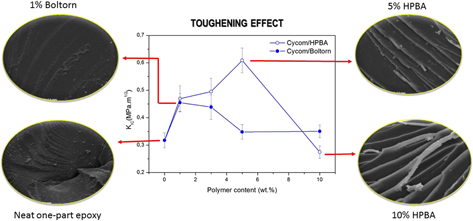Crossref Citations
This article has been cited by the following publications. This list is generated based on data provided by
Crossref.
Shiravand, Fatemeh
Ascione, Laura
Persico, Paola
Carfagna, Cosimo
Brocks, Thatiane
Cioffi, Maria Odila Hilário
Puglisi, Concetto
Samperi, Filippo
and
Ambrogi, Veronica
2016.
A novel hybrid linear–hyperbranched poly(butylene adipate) copolymer as an epoxy resin modifier with toughening effect.
Polymer International,
Vol. 65,
Issue. 3,
p.
308.
Sharifi, Mehrdad
Ebrahimi, Morteza
and
Jafarifard, Samane
2017.
Preparation and characterization of a high performance powder coating based on epoxy/clay nanocomposite.
Progress in Organic Coatings,
Vol. 106,
Issue. ,
p.
69.
Bonadies, Irene
Maglione, Luca
Ambrogi, Veronica
Paccez, Juliano D.
Zerbini, Luiz F.
Rocha e Silva, Luiz F.
Picanço, Neila S.
Tadei, Wanderli P.
Grafova, Iryna
Grafov, Andriy
and
Carfagna, Cosimo
2017.
Electrospun core/shell nanofibers as designed devices for efficient Artemisinin delivery.
European Polymer Journal,
Vol. 89,
Issue. ,
p.
211.
Kumar, Sudheer
Krishnan, Sukhila
Samal, Sushanta K.
Mohanty, Smita
and
Nayak, Sanjay K.
2018.
Toughening of Petroleum Based (DGEBA) Epoxy Resins with Various Renewable Resources Based Flexible Chains for High Performance Applications: A Review.
Industrial & Engineering Chemistry Research,
Vol. 57,
Issue. 8,
p.
2711.
Lou, Chunhua
and
Liu, Xijun
2018.
Functional dendritic curing agent for epoxy resin: Processing, mechanical performance and curing/toughening mechanism.
Composites Part B: Engineering,
Vol. 136,
Issue. ,
p.
20.
Muralishwara, K
Kini, U Achutha
and
Sharma, Sathyashankara
2019.
Epoxy-clay nanocomposite coatings: a review on synthesis and characterization.
Materials Research Express,
Vol. 6,
Issue. 8,
p.
082007.
Ratna, Debdatta
2022.
Recent Advances and Applications of Thermoset Resins.
p.
293.
Niu, Chunmei
Du, Kaipeng
Xu, Zheng
Li, Zhiqiang
Li, Tiantian
and
Wang, Ruolin
2023.
Mechanical properties of epoxy resin composites modified by epoxy styrene‐butadiene latex.
Journal of Applied Polymer Science,
Vol. 140,
Issue. 26,
Liu, Hansong
Sun, Jinsong
Zhang, Lianwang
Liu, Zhaobo
Huang, Chengyu
Sun, Mingchen
Duan, Ziqi
Wang, Wenge
Zhong, Xiangyu
and
Bao, Jianwen
2024.
Influence of the Second-Phase Resin Structure on the Interfacial Shear Strength of Carbon Fiber/Epoxy Resin.
Materials,
Vol. 17,
Issue. 6,
p.
1323.
Lim, William Yung Ling
Jaafar, Mariatti
Ishak, Ku Marsilla Ku
Chan, Wooi Keong
and
Chinniah, Karuna
2024.
Effect of hyperbranched polymer as toughener on tensile, thermal and electrical properties of thin film epoxy composites.
Journal of Physics: Conference Series,
Vol. 2907,
Issue. 1,
p.
012008.
Pan, Kai
Yang, Su
Tao, Xiang
Xi, Zhiwei
Lin, Yijun
Wang, Lijie
Huang, Chunfang
and
Li, Xiaojie
2024.
Enhancing corrosion resistance and toughness of solvent-free epoxy coatings with low-viscosity fluorine-containing hyperbranched polyether.
Progress in Organic Coatings,
Vol. 187,
Issue. ,
p.
108149.
Li, Xiaohuan
Zhang, Tongjia
Qiu, Shoutian
Zhang, Xingdi
Zhao, Jiyong
Li, Donghan
and
Wang, Honghua
2024.
Long Chain Branched Phenolphthalein Poly(ether sulfone) for Effective Toughness Improvement in Epoxy Networks.
ACS Applied Polymer Materials,
Vol. 6,
Issue. 22,
p.
13775.
Niu, Peixin
Zhao, Zhiying
Zhu, Jun
Zhang, Zhiyan
Sun, Ailing
Wei, Liuhe
and
Li, Yuhan
2025.
Epoxy-based multifunctional re-bondable polymer with self-healing, shape memory and superb bonding properties.
Journal of Colloid and Interface Science,
Vol. 678,
Issue. ,
p.
30.
